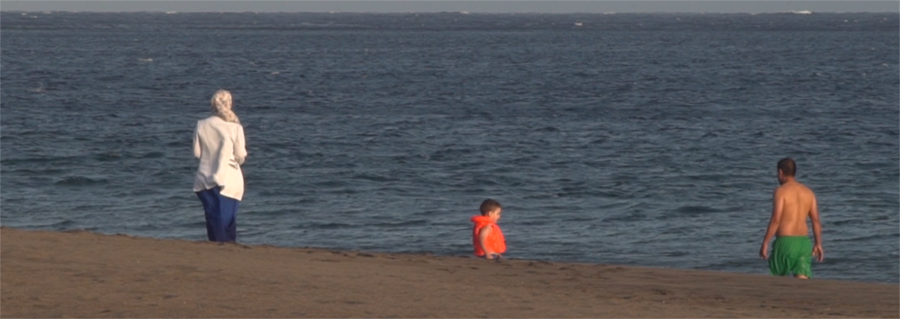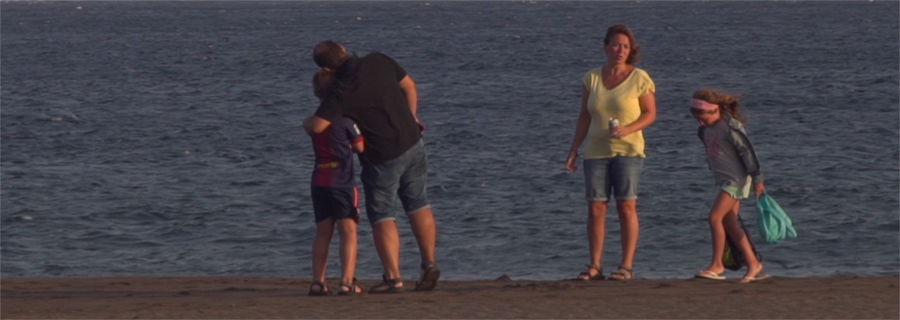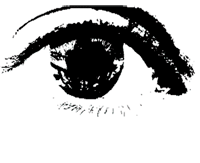Cuerpos Invisibles // DOCUMENTARY /#HUMAN-RIGHTS #BODIES #MIGRATION / 2020
cuerpos invisibles
Un documental de Sara Serrano y Selu Herraiz basado en la mediación cultural y sociopolítica entre artistas y juristas frente a un fenómeno trágico y su contexto: la migración como única vía de escape vital.
Un trabajo de campo profundo, enfocándose especialmente en la inmigración saharaui, a través de grabaciones del paisaje y una serie de entrevistas con personas en diversos estados de regularización.
"Invisible Bodies" está estructurado en torno a dos ejes: la visión del artista y la visión del jurista. Esta perspectiva dual se centra en el mismo tema o realidad: los cuerpos que la sociedad quiere volver invisibles y, paradójicamente, se vuelven más presentes como resultado. Estos son los cuerpos que, incluso en la isla de Tenerife, ocupan un espacio que parece no pertenecerles por origen. Son los cuerpos migrantes.
#cuerpos #invisibilidad #migrante #poesía #instalación #audiovisual #sonido #Derechos Humanos #Emigracion/Inmigracion
///ENGLISH BELOW///

Producción: Javier Cuevas
Asesor / Jurista: Vanesa Hernández
Intervienen: Sukeina Ndiaye, A.J , Z.B.
Colaboran Solar / Lav Ciudad / Cabildo Tenerife

Pedir contraseña en / ask for the password in seluherraiz@gmail.com
Una inmersión experiencial y sensitiva, pero también analítica y documental, sobre una cuestión que nos atañe a todas y a todos, la movilidad de las personas por cuestiones políticas, económicas y/o de conflicto bélico/violencia.
Al igual que no podemos huir de nuestro propio cuerpo porque -como dice Santiago Alba Rico- “a veces tiene hambre, se aburre, enferma y finalmente muere. Así el cuerpo nos reabsorbe”. Tampoco podemos huir de la evidencia del cuerpo inmigrante y de su existencia, aunque nos aseguremos de que queden escondidos en los rincones más inhóspitos de la ciudad o encerrados entre las paredes de un CIE. El cuerpo no se volatiliza, el cuerpo sigue ahí, incluso “obscenamente” (fuera de la escena), más presente por contraposición al intento de hacerlo desaparecer. Nada se hace más presente que lo que molesta, que lo que “difiere”.
Porque a pesar de todo intento del sistema de convertir los cuerpos en un simple reflejo, en la propia imagen de ellos mismos, desmaterializándolos cada vez más, todavía son necesarias las fronteras en forma de muro para bloquear su paso. Y esto los hace aún más físicos, más contundentes.
Qué? miedo y qué? capacidad de esquivar la mirada nos permite dejar a un lado de nuestra agenda diaria algo de esta naturaleza que sucede a nuestro lado. Qué? cantidad “sobrehumana” de ruido, imagen, entretenimiento, disgregación y adiestramiento nos rodea que silencia e invisibiliza el sufrimiento de los cuerpos de nuestra propia especie.
Este proyecto nace a partir del deseo de dar visibilidad al núcleo de población migrante y a las relaciones de negación entre esta población migrante y la población local. En esta deriva audiovisual, queremos “con mover” la mirada del espectador ante esta cuestión, visibilizarla y provocar un deseo de implicación.

///ENGLISH///
A documentary by Sara Serrano and Selu Herraiz based on cultural and sociopolitical mediation between artists and jurists facing a tragic phenomenon and its context: migration as the only vital escape.
A deep fieldwork, focusing especially on Saharawi immigration, through recordings of the landscape and a series of interviews with people in various states of regularization.
"Invisible Bodies" is structured around two axes: the vision of the artist and the vision of the jurist. This dual perspective focuses on the same theme or reality: the bodies that society wants to render invisible and, paradoxically, become more present as a result. These are the bodies that, even on the island of Tenerife, occupy a space that seems not to belong to them by origin. They are the migrant bodies.
An experiential and sensitive immersion, but also analytical and documentary, about an issue that concerns us all, the mobility of people for poliotical, economic and/or war conflicts/violence reasons.
Just like we can't run from our own body because - like Santiago Alba Rico said- “sometimes it is hungry, bored, sick and finally dies”. We can't run from the evidence either of the immigrant body and its existence, although we make sure that they remain hidden in the most inhospitable corners of the city or enclosed within the walls of an ICD. The body does not volatilize, the body is still there, even "obscenely" (out of the scene), more present in contrast to the attempt to make it disappear. Nothing become more present than what bothers, than what "differs."
Because, despite all attempts of the system to turn bodies into a simple reflection, in their own image, dematerializing them more and more, they are still necessary borders in the form of a wall to block their passage. And this makes them still more physical, more forceful.
What fear and what ability to avoid the gaze allows us to put aside from our daily agenda something of this nature that happens next to us. What amount of noise, image, entertainment, disintegration and training surrounds us that silences and makes invisible the suffering of the bodies of our own species.
This project was born from the desire to give visibility to the nucleus of the migrant population and to the relations of denial between this migrant population and the local population. In this audiovisual drift, we want to move the viewer's gaze to this question, make it visible and provoke a desire for involvement.








